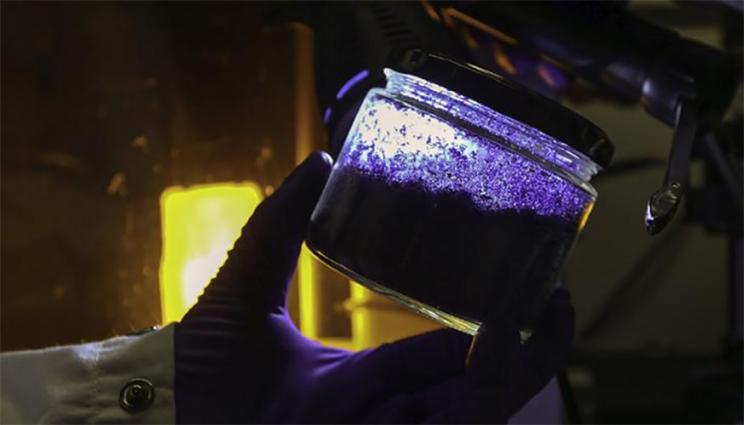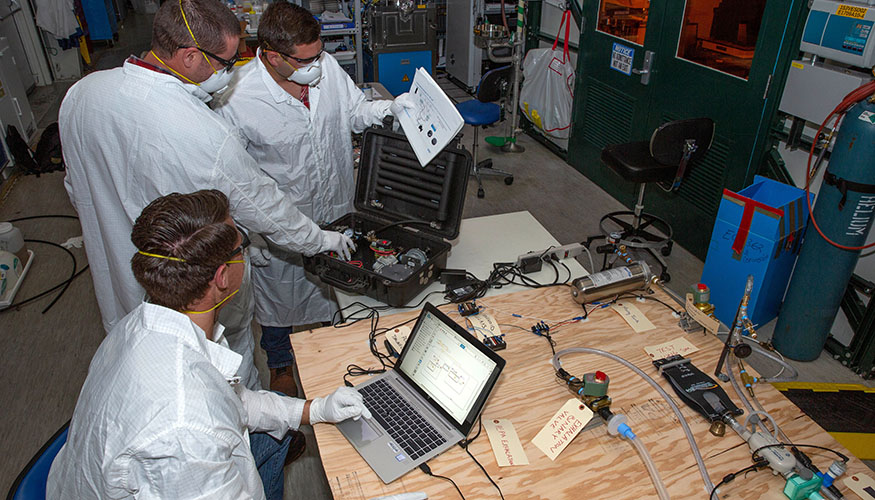
A jar of microcapsules produced through direct dry collection with the In-air Drop Encapsulation Apparatus. A Livermore team won an "outstanding technology development" award for the Federal Laboratory Consortium's Far West/Mid-Continent region. Photo by Julie Russell/LLNL
Two teams of Lawrence Livermore National Laboratory (LLNL) scientists and engineers, each supported by a Lab business development executive, have garnered regional awards for technology transfer.
This year's awards, one for outstanding technology development and the other for an outstanding partnership, will be presented next week during the Federal Laboratory Consortium's (FLC) Far West/Mid-Continent regional meeting.
Registration is now open - and free - for the two-day virtual meeting, set for Nov. 17 and 18. Lab employees who would like to register for the Nov. 17 awards ceremony, which will run from 1:15 to 1:45 p.m. Pacific time, can do so here. The event can be viewed using this link.
Started in 1974, the FLC assists the U.S. public and private sectors in utilizing technologies developed by federal government research laboratories. It is comprised of more than 300 federal government labs and research centers.
With its awards this month, LLNL has now netted 38 regional awards for technology transfer from the FLC since 2007.
Top technology development
For decades, microcapsule research and development has offered the potential of many new markets and applications, and this market need is growing since the discovery of monodisperse capsule fabrication via microfluidics - but commercialization has been hampered by needed improvements in production methods.
Now LLNL scientists and engineers, in collaboration with Purdue University researchers, have developed the In-air Drop Encapsulation Apparatus (IDEA), which creates microcapsules of consistent size and composition at a rate 100 times faster than current microfluidic-based, single dispersal capsule production techniques, and up to 1,000 times faster when incorporated with a multi-nozzle design. Because capsules can be produced in air instead of solely in liquid, the post-process time and material waste can be reduced by up to 99 percent.
For their work, the team will receive an "outstanding technology development" award for the FLC's Far West/Mid-Continent region.
The core-shell and structure of IDEA microcapsules can be tailored to a range of sizes and shapes that suit industrial and biotechnology applications.
Livermore initially applied the IDEA technology to micro-encapsulated carbon dioxide sorbents (MECS) that can enhance carbon capture from coal-burning power plants, industry processes and now commercial use for indoor space air purification.
With MECS, carbon-capture solvents are separated from the environment by the shell membrane, enabling use of solvents, such as sodium carbonate, that are otherwise too slow-reacting for industry use. The capsules safely absorb carbon dioxide (CO2) up to 10 times faster than unencapsulated solvents and permit CO2 transportation and regeneration by heat or diffusion.
In addition, to carbon capture for power plants or industry operations, Lab researchers have identified a number of applications that could benefit from the IDEA technology's ability to mass produce consistent, tailored microcapsules: rare earth element recycling, drug delivery, even cutting costs for breweries through CO2 reclamation.
The Lab IDEA team is led by materials engineer Congwang Ye and includes materials engineers Kevin Paulsen, Will Smith, Caitlyn Cook, Eric Duoss, Elaine Lee and Ashley Hall; mechanical engineers Julie Mancini and Kenneth Enstrom; materials chemist Sarah Baker; materials scientist Joshua Kuntz; polymer chemist James Oakdale; environmental engineer Joshuah Stolaroff; chemical engineers Andrew Pascall and Marcus Worsley; and Roger Aines, chief scientist of the Energy Program.
Annemarie Meike is the business development executive (BDE) in the Innovation and Partnerships Office (IPO) who handles the IDEA technology.
Partnership lauded
As the COVID-19 pandemic surged and concern emerged over a potential nationwide shortage of ventilators, LLNL researchers began designing a durable, portable mechanical ventilator to help fill the gap.
A group of approximately 20 engineers and scientists began prototyping a ventilator that could be made from non-traditional parts, preventing further stress on the already-strained supply chain.
In just over three months, LLNL and industry partner BioMedInnovations, LLC (BMI) of North Carolina designed, produced and tested an easily reproducible design prototype while partnering with manufacturing facilities and gaining Food and Drug Administration (FDA) authorization for the device's emergency use.

This work has netted an "outstanding partnership" award for LLNL and BMI from the FLC.
This collaboration was largely done remotely, with scientists, engineers and medical experts contributing from home offices, in many cases, due to shelter-in-place orders.
While industry partnerships forged in cooperative research and development agreements (CRADAs) often take years to deliver a commercial product, particularly a medical device, the LLNL/BMI CRADA produced the SuppleVent™ emergency ventilator - FDA-cleared for use and approved for sale - in just a few months.
BMI estimates the cost of the suitcase-sized SuppleVent units will be a small fraction of a traditional ventilator, making SuppleVent easy to deploy in case of a sudden resurgence of COVID-19.
The LLNL ventilator effort is led by mechanical engineer Jack Kotovsky and includes mechanical engineers, Austin Nye, Patrick Scholl, Matt Pharr, Ken Enstrom, Ian Ladner and Dan Manha; mechanical technologists Aaron Sperry, Greg Norton and Victor Vargas; electrical engineers Doug Modlin, Jack Dean and Brian Wihl; physicists Jacob Trueblood and Phil Paul; biomedical engineers David Soscia, Michael Triplett and Jeremy Gleick; chemical engineer Allison Yorita; precision engineer Steven Guzorek; administrator Shaine Athey; and Patrick Dempsey, the director of strategic partnerships and communications for Engineering.
Genaro Mempin is the IPO BDE who has handled the technology transfer work, including a CRADA, for the ventilator project, with assistance from Alicera Aubel, an IPO agreements specialist.






